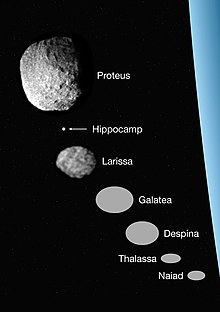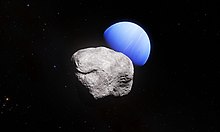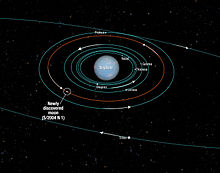Hippocamp (moon)
synchronous | |
| Albedo | ≈0.09 (assumed)[6] |
|---|---|
| 26.5±0.3[5] | |
Hippocamp, also designated Neptune XIV, is a small
History
Discovery
Hippocamp was discovered by a team of
To confirm the moon, Showalter further analyzed over 150 archival Hubble images going back to 2004.[7] Within a week, Showalter repeatedly found Hippocamp in these images and was able to identify the moon at ten different observation times from 2004 to 2009.[5][9] Showalter had also checked images from the Voyager 2 spacecraft to find any detections of Hippocamp during its 1989 Neptune flyby, but was unable to identify the moon since it was too dim to be detected by Voyager 2's cameras. Nonetheless, the number of archival Hubble images with Hippocamp was enough to determine the moon's orbit.[7][5][8] The discovery of Hippocamp was formally announced in a notice issued by the International Astronomical Union's Central Bureau for Astronomical Telegrams, along with a press release by the Space Telescope Science Institute on 15 July 2013.[5][7] Given that the relevant images examined by Showalter were available to the public, the discovery could have been made by anyone.[8]
Naming
The moon is named after the hippocampus, a mythological creature depicted as having the upper body of a horse with the lower body of a fish in Greek mythology.[10] The hippocampus symbolizes the Greek sea god Poseidon as well as the Roman sea god Neptune.[11][10] In Roman mythology, Neptune would often drive a sea-chariot pulled by hippocampi.[10]
Upon the announcement of its discovery, the moon was given the
By the International Astronomical Union's (IAU's) nomenclature guidelines, name proposals for Neptune's moons must be based on a figure from Greco-Roman mythology with a relationship to Poseidon or Neptune.[11][14] Showalter and his team had sought for names since the announcement of their discovery; among the names considered was Polyphemus, the gigantic one-eyed son of Poseidon and Thoosa.[15] Showalter then settled on the name Hippocamp in acknowledgement of the seahorse genus, Hippocampus, mainly for his passion for scuba diving and the animal itself.[16] Showalter's name proposal was approved by the IAU's naming committee on 20 February 2019, and the name was announced in a press release by the Space Telescope Science Institute.[17][14]
Origin

The mass distribution of the Neptunian moons is the most lopsided of the satellite systems of the giant planets in the Solar System. One moon, Triton, makes up nearly all of the mass of the system, with all other moons together comprising only one third of one percent. The reason for the lopsidedness of the present Neptunian system is that Triton was captured from the Kuiper belt well after the formation of Neptune's original satellite system, much of which was destroyed in the process of capture. Triton's orbit upon capture is presumed to have been highly eccentric, which would have caused chaotic perturbations in the orbits of the original inner Neptunian satellites, leading to the ejection of some moons and the collisional destruction of others.[18][19] At least some of Neptune's present inner satellites are thought to have then accreted from the resulting rubble after Triton's orbit was circularized by tidal deceleration.[20]
Among these re-accreted moons are
Based on this evidence, Showalter and colleagues proposed that Hippocamp may have originated from debris ejected from Proteus by the cometary impact that formed its largest crater, Pharos. In this scenario, Hippocamp would be considered as a third-generation satellite of Neptune, originating from impacts on Neptune's reformed regular moons after the capture of Triton.[10] The regular moons of Neptune are thought to have been disrupted by cometary impacts multiple times, with only Proteus surviving intact despite being nearly disrupted by the Pharos impact event.[18] Some of the debris ejected by the impact settled into a stable orbit 1,000–2,000 km (620–1,240 mi) interior to Proteus, and coalesced into Hippocamp.[6] However, Hippocamp only accounts for two percent of the missing volume of material generated by the Pharos impact event, and the reason for the absence of the rest of the debris remains unknown.[22]
As with the other small inner moons of Neptune, Hippocamp is thought to have been repeatedly disrupted by comet impacts after it had coalesced from debris ejected from Proteus. Based on the formation rate of large craters on Proteus, Hippocamp is estimated to have been disrupted about nine times in the past 4 billion years, re-accreting back after each disruption event.
Physical characteristics

Hippocamp is the second-smallest known moon of Neptune, with a diameter estimated at 34.8 km (21.6 mi). It is about 1,000 times less massive and 4,000 times less voluminous than its hypothesized progenitor, Proteus.[6][14] Based on Hippocamp's estimated apparent magnitude of 26.5, its diameter was initially thought to be around 16–20 km (10–12 mi), but more recent observations revise this value upward two-fold.[5][6] Nevertheless, it remains by a wide margin the smallest of Neptune's inner, regular, satellites.[22]
The surface properties of Hippocamp are unknown as it was not extensively studied through different
Orbit

Hippocamp completes one revolution around Neptune every 22 hours and 48 minutes (0.95 days), corresponding to a
Being situated at a relatively close distance to the much larger Proteus, Hippocamp is subjected to its significant gravitational influence.[6] Its orbit is particularly sensitive to the mass of Proteus; orbital solutions using a variety of assumed masses for Proteus show that Hippocamp displays a significant in-orbit difference of around 100 km (62 mi). This can allow for an estimate of the mass of Proteus by observing its influence on Hippocamp's orbit for over a period of several decades.[4]
Proteus and Hippocamp are nearly in a 11:13
Notes
- ^ The relative brightness of the moons is exaggerated in this composite of high and low exposure images. The color image of Neptune was taken separately by Hubble in August 2009.
- ^ Mass range for assumed densities of 0.05–1.50 g/cm3.[4]
- ^ Given Neptune’s radius of 24,600 km[4] and the Moon's semi-major axis of 384,400 km.[27]
- ^ Given the moons' respective periods of 0.55465 and 0.95 days, the actual ratios are 2.92:5.00.[27]
References
- ^ "Planetary Satellite Discovery Circumstances". Jet Propulsion Laboratory. 28 October 2019. Retrieved 21 June 2020.
- ^ "Hippocamp". Lexico UK English Dictionary. Oxford University Press. Archived from the original on October 17, 2020.
- ^ Anon. (1899) "Invocation to Neptune", Poems, New York, p. 84
- ^ S2CID 204960799.
- ^ Bibcode:2013CBET.3586....1S. Retrieved 21 June 2020.
- ^ PMID 30787452.)
{{cite journal}}: CS1 maint: date and year (link - ^ a b c d "Hubble Finds New Neptune Moon". HubbleSite. Space Telescope Science Institute. 15 July 2013. Retrieved 15 July 2013.
- ^ a b c Beatty, Kelly (15 July 2013). "Neptune's Newest Moon". Sky & Telescope. Retrieved 12 June 2017.
- ^ Showalter, Mark (15 July 2013). "How to Photograph a Racehorse ...and how this relates to a tiny moon of Neptune". Cosmic Diary. Retrieved 16 July 2013.
- ^ a b c d e "Hubble helps uncover origin of Neptune's smallest moon Hippocamp". Spacetelescope.org. European Space Agency. 20 February 2019. Retrieved 21 February 2019.
- ^ a b "Planet and Satellite Names and Discoverers". Gazetteer of Planetary Nomenclature. USGS Astrogeology Science Center. Retrieved 22 June 2020.
- Bibcode:2015hst..prop14217S. Retrieved 25 June 2020.
- ^ a b "M.P.C. 111804" (PDF). Minor Planet Circular. Minor Planet Center. 25 September 2018. Retrieved 25 June 2020.
- ^ a b c d "Tiny Neptune Moon Spotted by Hubble May Have Broken from Larger Moon". HubbleSite. Space Telescope Science Institute. 20 February 2019. Retrieved 22 June 2020.
- ^ Billings, Lee (18 July 2013). "Neptune's New Moon May Be Named after One of Sea God's Monstrous Children". Scientific American. Retrieved 25 June 2020.
- ^ a b Beatty, Kelly (20 February 2019). "Meet Hippocamp, Neptune's Smallest Moon". Sky & Telescope. Retrieved 25 June 2020.
- ^ "Name Approved for Neptunian Satellite: Hippocamp". Gazetteer of Planetary Nomenclature. USGS Astrogeology Science Center. 20 February 2019. Retrieved 22 June 2020.
- ^ S2CID 34095237.
- S2CID 4420518.
- .
- .
- ^ PMID 30787456.
- ^ Haynes, Korey (20 February 2019). "Meet Neptune's new moon, Hippocamp". Astronomy Magazine. Retrieved 22 June 2020.
- .
- ISSN 0004-6256.
- S2CID 122085744.
- ^ a b "Planetary Satellite Mean Orbital Parameters". Jet Propulsion Laboratory. 17 July 2020. Retrieved 21 July 2020.
- ISSN 0019-1035.
External links
- Hippocamp In Depth, NASA Solar System Exploration, updated 19 December 2019
- A new moon for Neptune, Anne J. Verbiscer, Nature, 20 February 2019
- Tiny New Moon Discovered around Neptune, Miriam Kramer, Scientific American, 17 July 2013
- How to Photograph a Racehorse …and how this relates to a tiny moon of Neptune, Mark Showalter, Cosmic Diary (Mark Showalter's Blog), 15 July 2013






